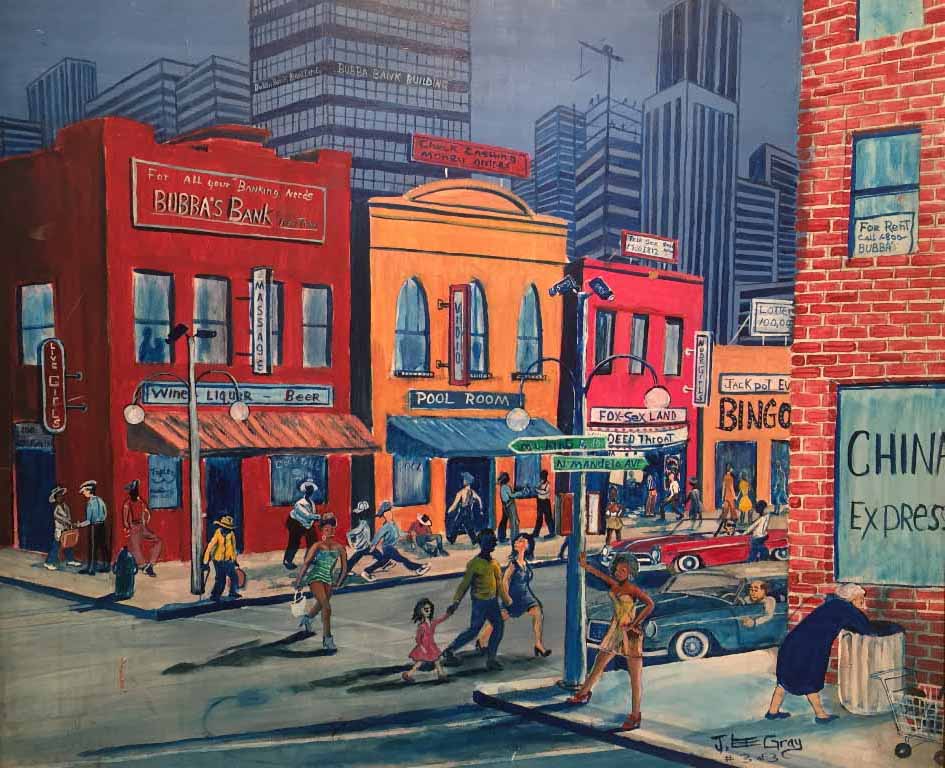Johnnie Lee Gray
Biography

After graduating from the county’s segregated Lincoln High School in 1960, Gray enlisted in the Army, where he served for seven years, including an 18-month volunteer tour of duty in Vietnam. As a Vietnam Veteran and self-taught artist, Gray’s work illustrated his experiences in the military as an African-American and the participation of black people in the history of the American and world landscape. Described as “visionary” “outsider” artist, the patterned shapes, visual texture, vibrant palettes and repetitive forms showcased in his paintings are recognizable characteristics of his historical narratives.
Recently earning his spot in history along notable artists like Jacob Lawrence and Robert Colescott, Gray’s parting prayer was that his wife of 22 years, Shirley Sims Gray, would be blessed through his artwork and provided for after he passed (2000). Mrs. Gray later went on to establish Art by J. Lee Gray, Inc, and serves as the CEO for this private collection. In 2004, one of his paintings—depicting sharecroppers picking cotton—sold for $100,000, a significant price for the work of an outsider artist.
A pivotal point in Johnnie Lee Gray’s career came after his death, when PBS and Thirteen/WNET New York reached out to Mrs.Gray to conduct an interview for their ongoing research on the African-American experience with legally enforced segregation, otherwise known as Jim Crow. While interviewing her, researchers discovered her husband’s extensive body of work revealing the storyteller they were looking for. Shortly after New York Life Insurance Company became the official corporate sponsor for the television series The Rise and Fall of Jim Crow, airing nationally in the fall of 2002, which prominently featured Grays work. This new attention and recognition prompted a traveling exhibition in 2003, curated by Dr. Gwendolyn H. Everett of Howard University, with its official opening night at the Schomburg Center for Research in Black Culture in Harlem, NY.
From 2003-2009, Johnnie Lee Gray’s work was exhibited in such venues as the Russell Senate Office Building Rotunda, Washington D.C.; The Forbes Galleries, Manhattan, NY; Chicago Historical Society, Chicago, IL; Atlanta History Center, Atlanta, GA; California State University, Northridge, CA; the Spartanburg County Museum of Art, SC; University of Virginia Art Museum, Charlottesville, VA; Gibbes Museum of Art, Charleston, SC; Morris Museum of Art, Augusta, GA; Livingstone College, Salisbury, NC; Converse College Milliken Art Gallery, Spartanburg, SC; the Schomburg Center for Research in Black Culture, Harlem, NY; and the Cherokee County History & Arts Museum, Gaffney, SC. 1
Significant exhibitions include traveling solo exhibits: “Rising Above Jim Crow: The paintings of Johnnie Lee Gray”, 2003 and “Landscape of Slavery: The Plantation in American Art”, 2007-2008.
1 Biography information sourced from Rising Above Jim Crow: The Paintings of Johnnie Lee Gray by Dr. Gwendolyn H. Everett, PH.D., 2004, New York Life Insurance Company